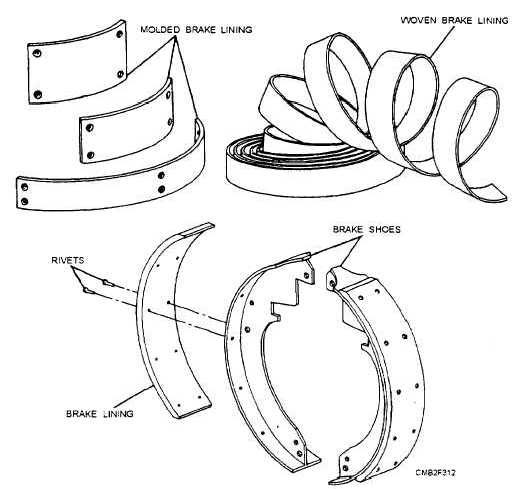The lining may also be bonded directly to the brake shoe. In this process, a special bonding agent (glue) is used to adhere the lining to the brake shoe. After application, the shoe is baked at a predetermined temperature to ensure proper setting of the bonding agent.
BRAKE SPRINGS. - The brake springs within the brake drum assembly are the retracting springs and the hold-down springs. The retracting springs pull the brake shoes away from the brake drum when the brake pedal is released. The springs apply pressure to the brake shoes which push the wheel cylinder pistons inward. The retracting springs fit in holes in the brake shoes and around the anchor pin at the top of the backing plate.
Hold-down springs hold the brake shoes against the backing plate when the brakes are in a released position. A hold-down pin fits through the back of the backing plate, the spring placed over the pin, and a metal cup locks onto the pins to secure the hold-down springs to the shoes. Other springs are used on the adjusting mechanism. Brake springs are high quality,

Figure 7-11. - Brake shoes and brake lining.
capable of withstanding the high temperatures encountered inside the brake drum.
BRAKE DRUMS. - The brake drum is attached to the wheel and provides the rotating surface for the brake linings to rub against to achieve braking action. The brake drum is grooved to mate with a lip on the backing plate that provides the rotating seal to keep water and dirt from entering the brake assembly.
Brake drums may be made of pressed steel, cast iron, a combination of the two metals, or aluminum. Cast-iron drums dissipate the heat generated by friction faster than steel drums and have a higher coefficient of friction with any particular brake lining. However, cast-iron drums of sufficient strength are heavier than steel drums. To provide lightweight and sufficient strength, use CENTRIFUSE brake drums (fig. 7-12). These drums are made of steel with a cast-iron liner for the braking surface. A solid cast-iron drum of the same total thickness as the centrifuse drum would be too weak, while one of sufficient strength would be too heavy for the average vehicle. 7-9
Continue Reading